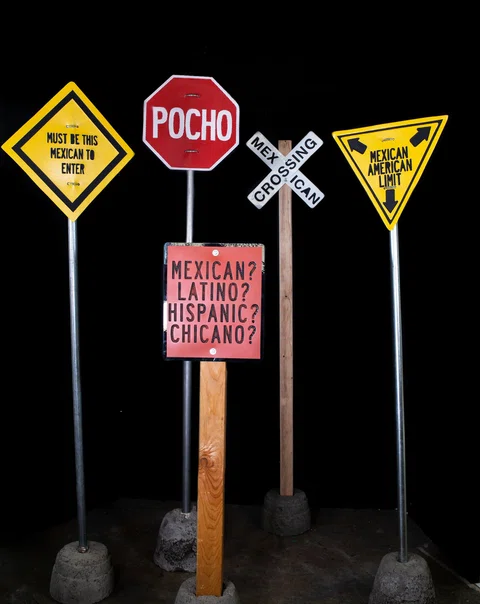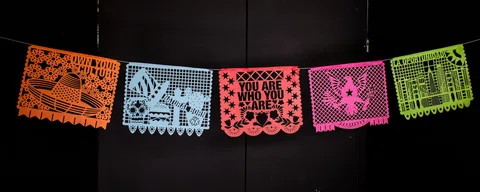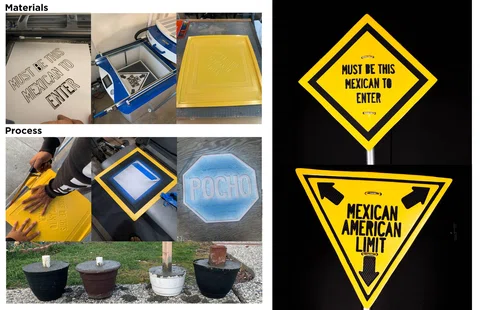



Mexican Signs|50 x 60 in|Matboards, HDPE plastic sheets, glossy and primer spray paint, steel rods, pinewood, concrete.
Cut mat board with a laser cutter, vacuum-formed onto thermoplastic at high temperatures, and spray painted.
Nicholas
Martinez
2-D
DesignMt. Diablo High School|Concord, CA


Papel Picado |11 x 78 in|Laser-cut double-layered tissue paper made with Epilog Laser Cutter.
Researched Mexican Papel Picado, then designed in Adobe Illustrator, and laser cut onto tissue paper.


I realized words, more importantly, signs can communicate very direct messages about questioning racial identities.
Student
statement
My art pieces, Mexican Signs and Papel Picado, explored my personal cultural conflicts. Growing up in a bi-cultural environment where I had to question my identity throughout my entire life made me want to create art that communicates how I feel about being Mexican-American.

Papel Picado | Composite photo showcasing detail photographs
I used various materials to create my work, including Polyethylene Plastic, mat boards, tissue paper, spray paint, and more. Throughout the year, I researched traditional Mexican media like printmaking, Papel Picado, and cultural decor. I used a blend of modern technology like laser cutting machines to a vacuum-former to create my artwork. There were many revisions of my designs. I had critiques and planned to be ambiguous with some works to effectively communicate my message to give the viewer a full experience.

Must Be This Mexican To Enter |77 x 21 x 3|Mat board, High Density Polyethylene Plastic sheet, flat black spray paint, metal rod, concrete.
Cut matboard with laser cutter, vacuum formed onto thermoplastic at high temperatures, spray painted
This year, I've used modern technologies such as laser cutting, vacuum forming, and Adobe Illustrator, combining them with traditional imagery to create conceptual illustrations representing the psychology of being Mexican-American.
Student
statement
Teacher
Statement
David Hevel
How does this work relate to your students' inquiry and investigation through art and design?
Nick began the year with the statement, “I want to make artwork about the conflict between my cultural and national identities. And, I want to make it as simple and direct as possible.” Nick is a very talented graphic designer and skilled at Illustrator and Photoshop. Although he used these skills to create his final work, he was very clear that he didn’t want his Adobe skill to be the central focus of the work. Nick’s wanted to make work using text that communicated a direct message. Through many experiments, he decided that signage was the most effective means to communicate his concept.
How did you support your student in developing skills with the ideas, materials, and processes used to make this work?
Nick’s portfolio proved to be an interesting challenge. I was often a technical consultant who advised on how to solve some of the challenges he encountered with the special equipment. I also helped facilitate difficult conversations around race, class, national, and cultural identity. Nick’s approach often involved making several digital mock-ups to share with classmates to get feedback. I was often involved in guiding questions and documenting the feedback for him to consider later.
What kinds of practice, experimentation, and revision were involved in making this work?
Nick took an almost sociological or anthropological approach to his artwork this year. He studied and wrote a 6-page essay about Mexican Printmaking, read many articles about contemporary Mexican artists, held discussions with the class race, stereotypes, and identity, and experimented with linocut, etchings, collage, and photography. He spent the better part of 12-weeks exploring without committing to a final concept. This resulted in a portfolio with a very wide approach to form with a very narrow concept about his relationship to his cultural identity.
What kind of learning experience, art/design challenge, and/or classroom environment did you provide to encourage your students' work?
The most important change that I made this year in my AP class was to allow the students the freedom to really explore without committing to a plan too early in the year. Previously, students would spend a period of time exploring media to complete their Breadth portion of the portfolio, but this was generally very guided by myself. Then they would have time to commit to a concentration.
This year, I allowed the students to explore without committing to a plan and encouraged them to play, experiment, and allow themselves to fail. This approach led Nick to discover various printmaking techniques, explore the laser cutter, vacuum forming machine, and digital media techniques. He stumbled often, and we delighted in his exploration failures. During this time, he began researching the identity politics of Mexican Printmaking, which later became the foundation of his sustained investigation.
What kinds of teaching and learning strategies did you use to support your students' thinking and making?
I met with students for 30-minutes in one-to-one critiques, where we talked about their opinions, challenges, and beliefs about the world and how they can make art within that space. I supplied the materials to explore, and the critiques resulted in the student identifying what they felt was successful and what needed improvement or what should be abandoned. Resources, articles, videos were shared to help them build or challenge their assumptions about their own work.
What is your advice to other teachers and students?
I feel the best strategy with the AP exam's new framework is to allow the students to develop their own artistic voice. Allow them to freedom to play, experiment with media without the pressure to make it perfect too soon. Try new media and try new techniques. In the beginning stages, challenge their thinking about a concept more than how their work is made. When they land on a solid concept, then they begin to develop the technique.
What did you learn from working with this student?
I learned the students have a lot to say about the world. I learned that listening and sharing relatable experiences will grow the mind of the student…the technique will come as they get older.

Nicholas Martinez
Terms of Use|Privacy Center
© 2020 College Board | PSAT/NMSQT is a registered trademark of the College Board and National Merit Scholarship Corporation.










